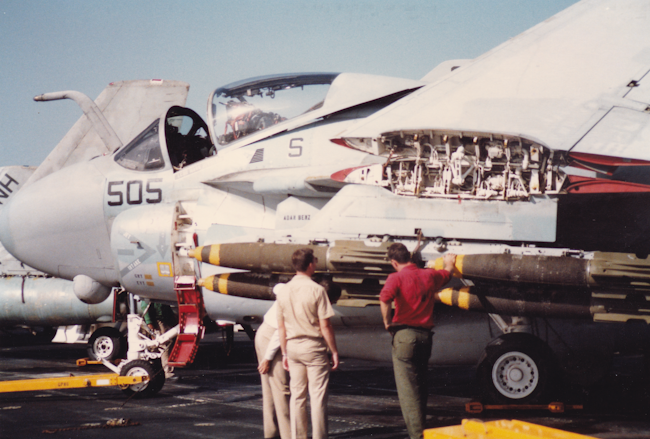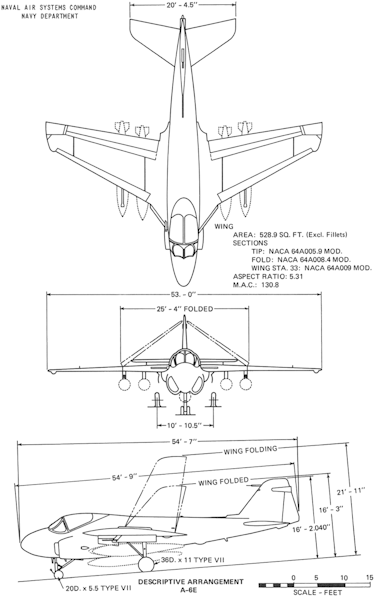Origins Of The Grumman A-6 Intruder
The Grumman A-6 Intruder is a notable American twinjet, all-weather attack aircraft, developed by Grumman Aerospace. It was operated by the U.S. Navy and Marine Corps. Known for its versatility, the A-6 Intruder played a crucial role in various military operations from its introduction in the early 1960s until its retirement in 1997. This aircraft is renowned for its capability to perform carrier-based attack missions under any weather conditions. The A-6 could carry a maximum payload of 18,000 pounds and had a combat range of 878 nautical miles.

VA-95 Lizard 504 on the catapults USS Enterprise
The Grumman A-6 Intruder was conceived in response to a 1957 mandate from the Bureau of Aeronautics, seeking an all-weather attack aircraft for the Navy’s long-range interdiction missions and featuring short takeoff and landing (STOL) capabilities for Marine close air support. This aircraft was intended to replace the piston-engined Douglas A-1 Skyraider. The requirements specified that the aircraft could utilize one or two engines, with the choice of turbojet or turboprop propulsion. Grumman’s successful proposal incorporated two Pratt & Whitney J52 turbojet engines.

The Intruder became the first Navy aircraft to integrate both the airframe and weapons system. With a crew of two seated side-by-side, the pilot and weapons officer (bombardier/navigator) shared operational responsibilities. It was equipped to carry both conventional and nuclear munitions, employing toss bombing techniques for the latter.
The first A-6 prototype took to the skies on April 19, 1960.
Grumman A-6 Intruder Manufacturing History
In response to a 1957 requirement by the Bureau of Aeronautics for an all-weather attack aircraft, Grumman developed the A-6 Intruder. The design aimed to replace the piston-engined Douglas A-1 Skyraider. The A-6 Intruder featured two Pratt & Whitney J52 turbojet engines. This aircraft was the first Navy aircraft integrating both airframe and weapons systems. It accommodated a crew of two, with a pilot and a bombardier/navigator seated side-by-side.
Several specialized versions of the A-6 were developed, often in response to urgent military needs that arose during the Vietnam War. Among these was the A-6C, a dedicated interdictor, and the KA-6D, equipped with buddy stores for aerial refueling. The most complex variant was the EA-6B Prowler, designed specifically for electronic warfare.
The final variant to be produced was the A-6E, which was introduced in 1972. It featured significant avionics upgrades, including the new APQ-148 multimode radar, along with minor refinements to the airframe. The last A-6E was delivered in 1992.
Operational History of The Grumman A-6
 The A-6 Intruder entered service in February 1963, with its initial deployment during the Vietnam War. It became the principal medium attack aircraft for both the U.S. Navy and Marine Corps. The aircraft’s long range and substantial payload made it invaluable. However, it was also vulnerable to anti-aircraft fire, resulting in the loss of 84 Intruders during the conflict. The A-6 Intruder continued to serve in various roles, including the Gulf War, until its retirement in 1997.
The A-6 Intruder entered service in February 1963, with its initial deployment during the Vietnam War. It became the principal medium attack aircraft for both the U.S. Navy and Marine Corps. The aircraft’s long range and substantial payload made it invaluable. However, it was also vulnerable to anti-aircraft fire, resulting in the loss of 84 Intruders during the conflict. The A-6 Intruder continued to serve in various roles, including the Gulf War, until its retirement in 1997.
The McDonnell Douglas A-12 Avenger II was supposed to replace the A-6, but the program was canceled due to escalating costs. As a result, the Intruder continued to serve for a few additional years before being phased out in favor of the F-14D Tomcat, equipped with LANTIRN. Eventually, the F-14D was succeeded by the F/A-18E/F Super Hornet in the U.S. Navy and the twin-seat F/A-18D Hornet in the U.S. Marine Corps. The final Intruders were officially retired on February 28, 1997.
Variants and Adaptations
During the Vietnam War, several specialized variants of the A-6 were developed to meet pressing military needs. One such variant was the A-6C, designed specifically for interdiction missions. Another was the KA-6D, an aerial refueling tanker equipped with a buddy store system. The most intricate variant was the EA-6B Prowler, tailored for electronic warfare operations. The final variant produced was the A-6E, introduced in 1972, which boasted significant avionics upgrades, including the advanced APQ-148 multimode radar, as well as minor airframe enhancements. Production of the A-6E continued until the last unit was delivered in 1992.
The A-6 Intruder is a twin-engined monoplane with a length of 54 feet 9 inches and a wingspan of 53 feet. It could carry a maximum payload of 18,000 pounds and had a combat range of 878 nautical miles. The aircraft was equipped with sophisticated avionics, including automatic diagnostic systems known as Basic Automated Checkout Equipment (BACE). These systems significantly reduced maintenance man-hours per flight hour.
Armament and Capabilities
VA-95 and the A-6 Intruder
April 1, 1972: Attack Squadron NINETY-FIVE was established. The squadron was assigned the Grumman A-6A Intruder. VA-95 served on the USS Coral Sea, USS Enterprise, and USS Abraham Lincoln for a total of 14 cruises.

VA-95 Lizard 505 with 500lb bomb loadout USS Enterprise
Operation End Sweep
April 1973: The squadron provided support for Operation End Sweep, the clearing of mine fields along the coast of North Vietnam.
Operation Frequent Wind
April 1975: Squadron aircraft participated in Operation Frequent Wind, the evacuation of American personnel from Saigon. The squadron provided armed escort flights over the Saigon area for protection of the helos conducting the evacuation.
Mayaguez Incident
On May 15, 1975, VA-95 was involved in the operation to recover the American merchant vessel SS Mayaguez, which had been seized by Cambodian gunboats. The squadron, known as the Green Lizards, conducted sorties to support Marine landings on Koh Tang Island and carried out retaliatory strikes against Cambodian targets.
During this mission, the squadron’s Intruders targeted the airfield and naval base at Ream, Cambodia. Additionally, Green Lizard KA-6D aircraft provided crucial tanker support for the combat missions.
Operation Earnest Will
Operation Earnest Will was an American military protection of Kuwaiti-owned tankers from Iranian attacks in 1987 and 1988. It was the largest naval convoy operation since World War II.
Operation Praying Mantis
On April 18 and 19, 1988, Attack Squadron NINETY-FIVE took part in Operation Praying Mantis, which involved retaliatory strikes against Iran after the USS Samuel B. Roberts (FFG 58) was damaged by an Iranian mine in international waters. The Green Lizard Intruders from the USS Enterprise (CVN 65) launched attacks on Iranian Boghammar speedboats using Rockeye cluster bombs, successfully sinking one and damaging another.

VA-95 Grumman A-6 “Lizard 506” with 500lb LGB and Harpoon missile loadout
 Later that day, the Iranian frigate Sahand launched missiles at two Green Lizard Intruders while they were conducting a surface combat air patrol for the USS Joseph Strauss (DDG 16). The Intruders successfully evaded the incoming missiles and counterattacked with two Harpoon missiles and four laser-guided Skipper bombs. Following this, the USS Joseph Strauss also fired a Harpoon missile at the Sahand. The combined assault set the Sahand ablaze, and the resulting fires eventually reached her magazines, leading to a series of explosions that caused her to sink.
Later that day, the Iranian frigate Sahand launched missiles at two Green Lizard Intruders while they were conducting a surface combat air patrol for the USS Joseph Strauss (DDG 16). The Intruders successfully evaded the incoming missiles and counterattacked with two Harpoon missiles and four laser-guided Skipper bombs. Following this, the USS Joseph Strauss also fired a Harpoon missile at the Sahand. The combined assault set the Sahand ablaze, and the resulting fires eventually reached her magazines, leading to a series of explosions that caused her to sink.
Subsequently, the Sahand’s sister ship, the Sabalan, emerged from port and engaged several VA-95 Intruders, launching a missile at them. In response, one of the Intruders dropped a laser-guided bomb on the Sabalan, leaving her dead in the water. The Sabalan was later towed by an Iranian tug, her fantail partially submerged. VA-95’s aircraft received orders not to continue the attack, and although the squadron remained on combat duty, no further engagements occurred.
Grumman A-6 Intruder Specifications
The A-6 Intruder featured five hardpoints, capable of carrying various combinations of rockets, missiles, and bombs. It was equipped to deliver conventional munitions as well as nuclear weapons. Its weaponry included AGM-65 Maverick air-to-ground missiles, AIM-9 Sidewinder air-to-air missiles, and laser-guided bombs. The aircraft’s advanced avionics and weapon systems made it a formidable asset in both conventional and nuclear warfare scenarios.
 General characteristics
General characteristics
Crew: 2 (pilot, bombardier/navigator)
Length: 54 ft 9 in (16.69 m)
Wingspan: 53 ft 0 in (16.15 m)
Width: 25 ft 2 in (7.67 m) wing folded
Height: 16 ft 2 in (4.93 m)
Wing area: 528.9 sq ft (49.14 m2)
Aspect ratio: 5.31:1[87]
Empty weight: 26,660 lb (12,093 kg)
Max takeoff weight: 60,400 lb (27,397 kg) (shore-based operations)
Fuel capacity: 2,385 US gal (1,986 imp gal; 9,030 L) (internal fuel)
Zero-lift drag coefficient: 0.0144[87]
Powerplant: 2 × Pratt & Whitney J52-P8B turbojets, 9,300 lbf (41 kN) thrust each
Performance
Maximum speed: 560 kn (640 mph, 1,040 km/h) at sea level
Cruise speed: 412 kn (474 mph, 763 km/h)
Stall speed: 98 kn (113 mph, 181 km/h) (flaps down)
Never exceed speed: 700 kn (810 mph, 1,300 km/h)
Combat range: 878 nmi (1,010 mi, 1,626 km) (with max payload)
Ferry range: 2,818 nmi (3,243 mi, 5,219 km)
Service ceiling: 42,400 ft (12,900 m)
g limits: -2.4 to 6.5
Rate of climb: 7,620 ft/min (38.7 m/s)
Lift-to-drag: 15.2[87]
Take-off run to 50 ft (15 m): 4,530 ft (1,380 m)
Landing run from 50 ft (15 m): 2,540 ft (770 m)
Armament
Hardpoints: Five hardpoints with a capacity of 3,600 lb (1,600 kg) each (4 under wings, 1 under fuselage), 18,000 lb (8,200 kg) total, with provisions to carry combinations of:
Rockets:
12× LAU-10 4-round 5 inch (127 mm) Zuni pods
12× LAU-68 7-round 2.75 inch (70 mm) FFAR pods
12× LAU-61/LAU-68 19-round 2.75 inch (70 mm) FFAR pods
Missiles:
AGM-45 Shrike anti-radar missile[88] × 2
AGM-78 Standard ARM anti-radar missile[89] × 2
AGM-62 Walleye TV-guided glide bomb[90]
AGM-65 Maverick air-to-ground missile[90] × 6
AGM-84 Harpoon anti-ship missile[90]/AGM-84E Standoff Land Attack Missile[91] × 4
AGM-88 HARM anti-radar missile
AGM-123 Skipper air-to-ground missile
AIM-9 Sidewinder air-to-air missile[92]
ADM-141 TALD decoy missiles[93]
Bombs:
28× Mk 82 500 lb (227 kg) GP bombs or Mk 20 Rockeye II cluster bomb[88][note 1]
13× Mk 83 1,000 lb (454 kg) GP bombs[88]
5× Mk 84 2,000 lb (907 kg) GP bombs[88]
5× GBU-12/16/10 laser-guided bombs
5× CBU-72 Fuel-Air Explosives[88]
Up to three B43, B57 or B61 nuclear weapons[88]
Other:
Mk 60 Captor Mine
Up to 5× 300 US gal (250 imp gal; 1,100 L) drop tanks
Various practice stores, chaff launchers, baggage pods, flares
References/Sources Consulted
Grumman A-6 Intruder
Intruder Association
The A-6 Intruder in Vietnam
Grumman A-6 Intruder: Carrierborne All-Weather Heavy Strike Aircraft
A-6E INTRUDER
USS Coral Sea (CV-43) 1973 Cruise Book
USS Coral Sea (CV-43) 1974-75 Cruise Book
USS Coral Sea (CV-43) 1977 Cruise Book
USS America (CV-66) 1979 Cruise Book
USS America (CV-66) 1981 Cruise Book
USS Enterprise (CVN-65) 1982-83 Cruise Book
USS Enterprise (CVN-65) 1984-85 Cruise Book
USS Enterprise (CVN-65) 1986 Cruise Book
USS Enterprise (CVN-65) 1988 Cruise Book
USS Enterprise (CVN-65) 1989-90 Cruise Book
USS Abraham Lincoln (CVN-72) 1989-1990 Cruise Book
USS Abraham Lincoln (CVN-72) 1991 Cruise Book
USS Abraham Lincoln (CVN-72) 1993 Cruise Book
USS Abraham Lincoln (CVN-72) 1995 Cruise Book
